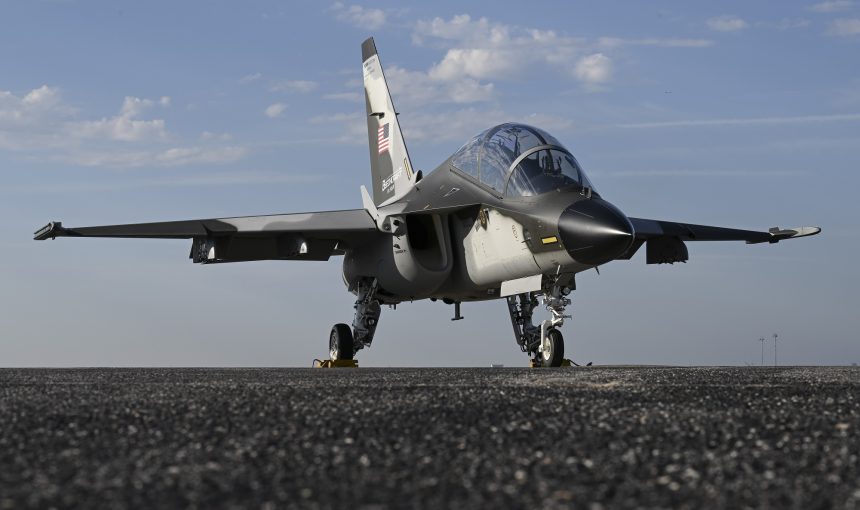Textron Aviation Defense will showcase the Beechcraft M-346N’s capabilities as a “ready-now” solution for the U.S. Navy Undergraduate Jet Training System.
Textron Aviation Defense has announced the launch of a U.S. tour to showcase the Beechcraft M-346N as a “ready-now” solution for the U.S. Navy Undergraduate Jet Training System (UJTS) program. An M-346 has been specifically brought to the U.S. for the tour, re-assembled at Textron Aviation Defense’s headquarters in Wichita, Kansas, and is now flying from Beech Factory Airport.
The aircraft has been flying in the U.S. since Sept. 9, as shown by flight tracking websites, with the collaboration of Leonardo’s test pilots and multiple flights already recorded. The M-346N is actually the demonstrator of the M-346FA (Fighter Attack), CPX625, which has been brought to the U.S. as representative of the platform while the Navy’s requirements are solidified.
Textron Aviation Defense and Leonardo, which developed the original M-346, teamed up in 2024 to offer the jet to the U.S. Navy. In July 2025, the two companies announced that the aircraft will be marketed as the Beechcraft M-346N.
Textron Aviation Defense’s and Leonardo’s Offering
Both companies have been working in the flight training sector for a long time, with Textron specifically working with the U.S. Navy for over 70 years. In fact, through Beechcraft, Textron provided the Navy with many turboprop trainers and, recognizing the maturity of the M-346, is now adding a jet aircraft to its lineup.
“With our heritage deeply rooted in the strength and reliability of American manufacturing, the Beechcraft M-346N joins a proud lineup of aircraft built on 95 years of aviation excellence,” says Travis Tyler, President and CEO of Textron Aviation Defense. “The aircraft can be the cornerstone for the Navy’s future of undergraduate jet training, combining operationally-proven performance with cutting-edge technologies.”
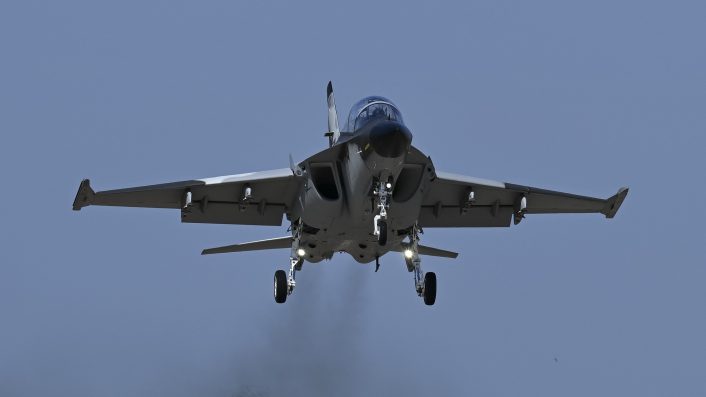
The Beechcraft M-346N jet is being offered as a “ready-now” solution to satisfy the Navy’s needs for the training of future naval aviators. The service has already released several Requests for Information (RFI) for the replacement of the T-45C Goshawk as part of the new UJTS program, and is expected to release a Request for Proposals (RFP).
“Assembled in the United States and backed by Beechcraft’s 85-year legacy of training U.S. military pilots, the M-346N represents the next evolution in jet trainer capability,” said Tyler in the tour’s announcement. “This platform is operationally proven and ready to deliver a comprehensive and advanced training solution to the U.S. Navy today.”
Leonardo and Textron Aviation Defense are counting on the experience maturated with more than 100 M-346 in service and over 150,000 flight hours logged worldwide, training pilots for 4th and 5th generation aircraft. The M-346 and its Integrated Training System have demonstrated exceptional performance and reliability in meeting the rigorous training demands of 20 global users, says Textron.
The aircraft is at the center of the globally renowned International Flight Training School in Italy, managed by Leonardo and the Italian Air Force. Notably, the IFTS is now also training U.S. Air Force pilots.
Beechcraft M-346N
The new M-346N is being developed on the proven integrated training system based on the original M-346. As Textron noted, the aircraft is already meeting the demanding student pilot training needs for 4th and 5th gen aircraft worldwide.
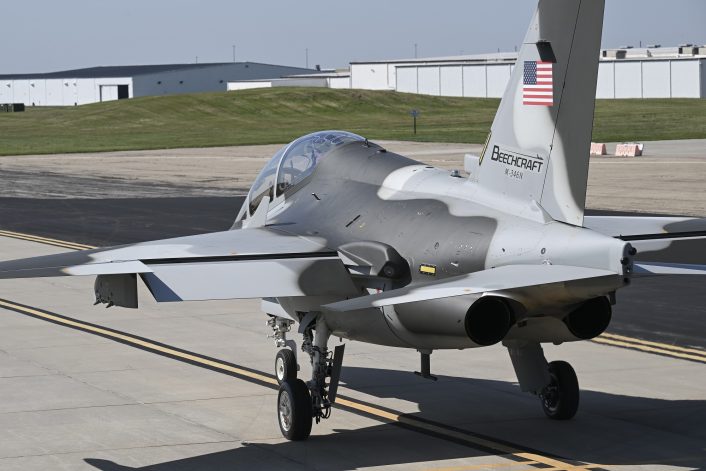
“The comprehensive M-346N integrated training ecosystem, which has been validated and continuously improved through the global operational experience of the M-346 integrated training system, is poised to provide the Navy with a complete solution that enhances student readiness and operational effectiveness while reducing training costs and risks,” says Textron.
Obviously, the M-346N will be adapted to the Navy’s needs with specific features required to prepare in the best way the new naval aviators for the high-performance world of carrier-based fighter operations. Among the features of the M-346N will be the Live Virtual and Constructive (LVC) system, which will challenge the students throughout the training by merging the real and virtual worlds.
Big Difference with the T-45
A big difference compared to the T-45 is that the M-346 will not be modified for carrier operations. A good portion of the training command’s syllabus is centered around the Field Carrier Landing Practice (FCLP), which allows new pilots to train on land bases for the entire approach and landing maneuver as performed on the aircraft carrier, just short of the arrested landing.
The FCLPs get the pilots ready to go to the ship at sea and do “the real thing,” which happens at a later stage of the training syllabus with the students deploying to an aircraft carrier with their T-45s. However, with the fifth RFI, the Navy said “the UJTS air vehicle will only be required to conduct Field Carrier Landing Practice (FCLP) to wave off.”
This eliminates the need for a lengthy and expensive redesign of the airframe required to withstand the forces involved in the unflared landings. An aircraft that has to trap on the carrier and launch from a catapult has to be designed from the ground up on that premise because the structural design needs to account for very significant stresses during carrier operations. A redesign of an already existing aircraft for such operations is not an easy feat and not always feasible.
Changes to UJTS in 2024
With the fourth RFI released in 2024, the Navy said the anticipated contract award date has been pushed from Fiscal Year 2026 to Q2FY2028. At the time, the service was still evaluating whether the UJTS air vehicle will need to conduct FCLPs to touchdown.
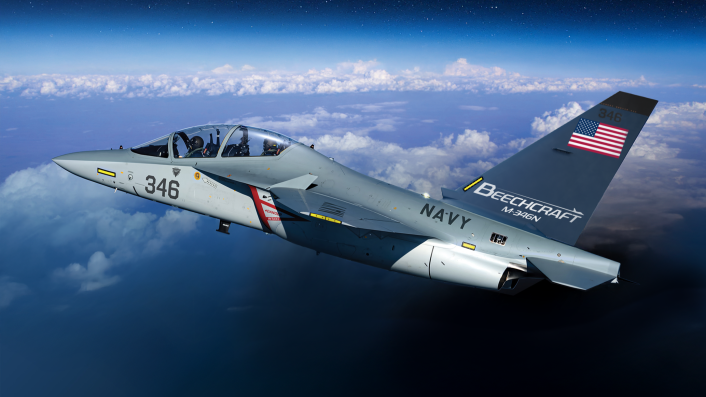
The RFI includes a list of desired attributes for the Navy’s new jet training aircraft, including zero-zero ejection seats and bird strike-resistant canopy. The latter is quite obvious as the Navy lost some aircraft because of the bird strike problem and obviously wants to minimize the chances of this happening again.
As for the cockpit configuration, the service is requesting an aircraft with Head-Up Display (HUD) and a “single, primary touch-screen display in both cockpits”, as well as Helmet Mounted Displays (HMD) with integrated Augmented Reality (AR) and capable of being used simultaneously or individually in the FWD and AFT cockpit. The Large Area Display (LAD) requirement was expected as the Navy already employs LADs on the F-35C and F/A-18 Block III aircraft that would be flown by pilots graduated on the UJTS.
The RFI then moves to suitability and performance attributes, beginning with the capability to maintain fixed Angle of Attack (AoA) approach targeting 3.25 degree glideslope while maintaining field of view during FCLPs. As for the performance, the Navy is looking for an aircraft capable of a speed of at least Mach 0.9/450-500 KIAS, sustained AoA over 20 deg, sustained load factor of at least 6 G, operating ceiling of at least 41,000 ft and turn rate of at least 12 deg/sec.
The new UJTS aircraft is also required to integrate the new Precision Landing Mode (PLM), which is now on F/A-18s and F-35s and will eventually be the standard method for approaching the aircraft carrier for all naval aircraft. PLM not only drastically reduces the number of corrections required during the final approach to the aircraft carrier, but could also lower the demand on the structure of the aircraft, reducing the need for structural modifications.
Changes to UJTS in 2025
The latest RFI changed again the award date, projecting it in January 2027. The RFI also mentioned that the “UJTS program is on an accelerated procurement timeline.” The service reached a decision on one of the most important aspects for the design of the T-45’s replacement. In fact, the new RFI now states that “the UJTS air vehicle will only be required to conduct Field Carrier Landing Practice (FCLP) to wave off.”
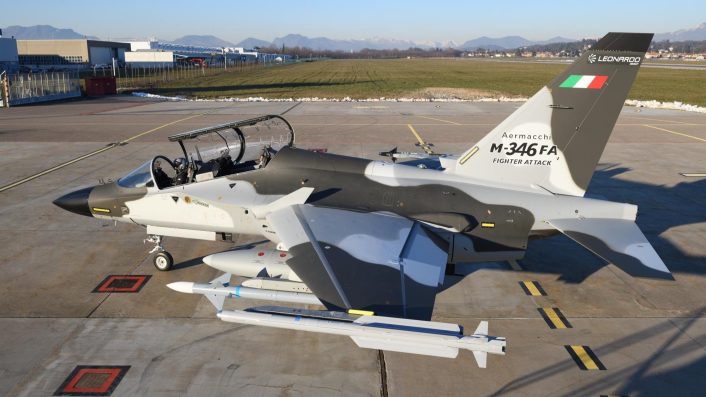
With the new requirement, future student pilots will only perform the approach phase of the current FCLP, going around once reached the minimums, without touching down on the runway. This eliminates the need for a lengthy redesign of the aircraft to allow it to withstand the forces involved in the unflared landings.
The Navy says that this decision, which sets a completely different route compared to the T-45 Goshawk and, previously, the T-2 Buckeye, is “due to advancements in operational platform landing modes and in ground-based simulation.” This means the new naval aviators will rely more on automation and perform complete FCLPs only in the flight simulator.
You can read our in-depth report about the M-346N and the UJTS here.
The article has been updated to reflect the absence of modifications to the aircraft and the correct date of the first flight in the U.S. provided by Textron Aviation.

